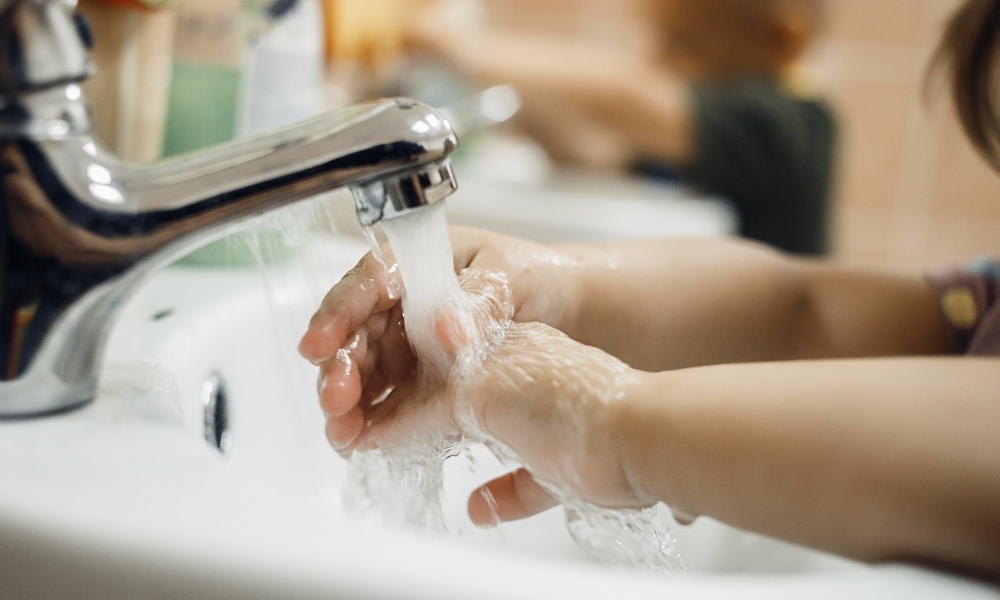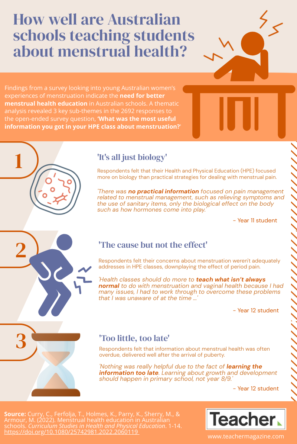‘It's one of those things that people don't feel comfortable talking about. Why is it so difficult to have that conversation when it is absolutely critical for our social wellbeing as well as our health?’
Bronwyn Robinson is the Education Manager at the Continence Foundation of Australia – the national peak body for bladder and bowel control health. The Foundation’s work includes supporting and providing education for leaders and classroom practitioners in mainstream and specialist schools, across primary and secondary.
Robinson explains there are a few reasons why children attending school are not toilet trained or have difficulties maintaining either urinary or faecal continence. ‘There's a group of children who have trouble with their continence and this can be caused by physiological reasons, or problems with the messaging that goes from the brain down to the bladder and bowel. Some children are born with fetal abnormalities (with their bowel, for example); you have children with cerebral palsy, spina bifida, acquired brain injury, spinal cord injury and children on the autism spectrum who may require additional assistance with toileting while in the school setting.
‘But then you add another layer of complexity when children start school and they're still not toilet trained. Children are ready to toilet train between about two-and-a-half and three-and-a-half – it depends on the child, depends on gender (girls usually toilet train faster and earlier than boys). Yet there’s anecdotal evidence that is saying children are starting school without having attained continence. Parent’s may be unsure how to undertake toilet training or it can slip when children are moving between home and childcare.’
Schools can’t deny enrolment for a child who isn’t toilet trained, and Robinson says the onus can then be placed on the school.
‘This is causing problems. It is important to have a discussion with the parents and have them understand that the child needs to be toilet trained, otherwise they're at risk of wetting or soiling themselves, they'll become isolated, find it difficult to make friends, and incontinence can have a negative impact on their self-esteem and quality of life.'
There are also children who are toilet trained but may start having difficulties while they’re at school. ‘It could be anxiety, change of environment, starting or changing schools, it could be that the school toilets aren't very friendly or they're smelly or they don't feel safe sitting on the toilet…’
Robinson says for those children who are anxious about using toilets at school this can have knock-on effects. ‘There are children who end up in hospital emergency with severe constipation because they have been hanging on for days. If you're constipated, you're more likely to wet yourself because the loaded bowel pushes down onto the bladder, and it can become a vicious cycle. In those instances, the conversation needs to be had between the school and the parent and a toileting plan developed and observed. So, things like letting the child go to the toilet at any time when they feel that urge – allowing children to go to the toilet when their bodies say they need to go, is really important.’
The Foundation runs a program for primary schools called Toilet Tactics, aimed at promoting healthy bladder and bowel habits and ensuring school toilets are welcoming for children. Resources include information for teachers, parents/carers and students, a school toilet checklist, tips on how to improve and maintain the facilities, and a student survey.
Robinson explains Toilet Tactics is a ‘whole of school approach’ to the management and care of all children around toileting. ‘The learning is designed for school nurses, classroom teachers, principals, the parent groups, teachers’ aides – anyone who might be working with children – and trying to give them some understandings around why certain toileting behaviours are happening, how it can be addressed and the roles and responsibilities within schools, and for parents as well.
‘There are quite a few strategies that schools might utilise for making the school toilets feel safe. It might be friendly colour schemes, maybe having older students who are sort of trustees to be around in the toilets when the little ones are there, maybe a buddy program or something along those lines for safety.’
It’s not just an issue for primary schools. Students starting secondary school who have ongoing health needs (such as students with National Disability Insurance Scheme support) or who were previously continent may also develop issues. The Foundation has a specialist website for adolescents, who often find it difficult to talk about their toileting experiences. ‘The assumption is that by the time you get to secondary school, you're much more able to hold on comfortably and wait until the bell goes, then go to the toilet. But if you haven't developed that skill or there is anxiety attached to going to the toilet, you're back being at risk of wetting or soiling yourself while you're still in class.’
Educators (including those in mainstream schools) may work with older students who need specialist toileting plans. ‘Again, that's a conversation that needs to be had between the families and the schools,’ Robinson says. 'Schools and parents must discuss the needs of the student and can be supported by appropriate health professionals. That could be a physiotherapist who helps with a toileting regime, an occupational therapist who can assist with a review of the site and the student’s needs and arrange toileting aids, or a child psychologist offering behavioural therapy programs.’
She adds it’s important for educators to understand the individual toileting plan and its aims, whether it’s supported toileting throughout the young person’s time at school, or having a goal of achieving toileting independence going into their adult life. This will vary depending on individual health needs.
‘So, we want to teach school staff about the development of continence: how children develop the skills to be able to identify when they need to go to the toilet and giving them strategies to communicate with parents and other staff members. With this approach you're constantly working towards an outcome that everybody, the parent, the child, the teacher and the school are all in agreement with and working towards. And it’s getting everybody involved in it – it is a collaboration.’
There is a selection of toilet training resources available on the Foundation’s website and these are free to download. Additionally, the Foundation is working on a new online course for teachers, resources for Kinder, and redeveloping its Toilet Tactics program and associated activity books. The Foundation also operates the National Continence Helpline (1800 33 00 66) which is a free telephone service staffed by Nurse Continence Specialists who offer confidential information, advice and support to people affected by incontinence or continence issues. It operates Monday to Friday from 8am-8pm AEST and is funded through the Australian Government Department of Health.
Stay tuned: In tomorrow’s article we’ll be speaking with Janie Thompson, Manager and Nurse Continence Specialist at the National Continence Helpline, about some of the real-life situations faced by educators who ring the helpline, along with strategies and advice.



